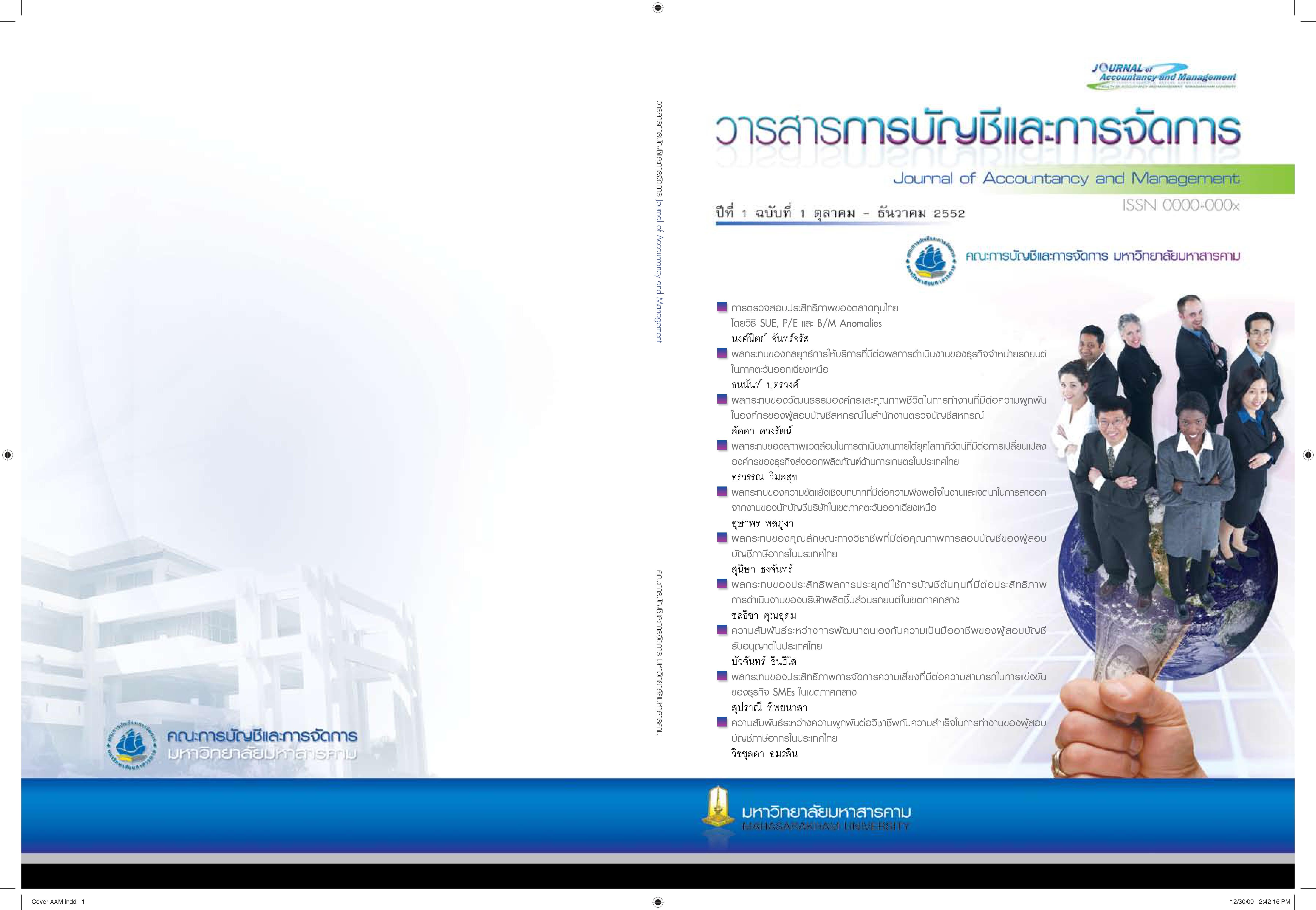ผลกระทบของประสิทธิภาพการจัดการความเสี่ยงที่มีต่อความสามารถ ในการแข่งขันของธุรกิจ SMEs ในเขตภาคกลาง
Main Article Content
บทคัดย่อ
การวิจัยครั้งนี้มีวัตถุประสงค์ เพื่อทดสอบผลกระทบของประสิทธิภาพการจัดการความเสี่ยงที่มีต่อความสามารถ ในการแข่งขันของธุรกิจ SMEs ในเขตภาคกลาง ซึ่งประสิทธิภาพการจัดการความเสี่ยงเป็นตัวแปรอิสระและเป็นตัวกำหนดความสามารถในการแข่งขัน โดยทำการเก็บรวบรวมข้อมูลจากผู้บริหารธุรกิจ SMEs ในเขตภาคกลาง เครื่องมือที่ใช้ ในการวิจัยเป็นแบบสอบถาม ใช้วิธีส่งจดหมายทางไปรษณีย์ โดยมีผู้ตอบแบบสอบถามที่มีเนื้อความ สมบูรณ์ทั้งสิ้น 142 คน สถิติที่ใช้ในการวิเคราะห์ข้อมูล ได้แก่ การวิเคราะห์สหสัมพันธ์พหุคูณ และการวิเคราะห์การถดถอยแบบพหุคูณ ผลการวิจัย พบว่า 1) ประสิทธิภาพการจัดการความเสี่ยง ด้านความสมดุลของต้นทุนและประโยชน์ที่ได้รับและด้านการพัฒนาอย่างต่อเนื่อง มีความสัมพันธ์และผลกระทบเชิงบวกกับความสามารถในการแข่งขันโดยรวม ด้านการเป็นผู้นำด้านต้นทุน ด้านความได้เปรียบการส่งมอบมูลค่าลูกค้า ด้านคุณภาพการจัดการเวลา และด้านความได้เปรียบทางนวัตกรรม 2) ประสิทธิภาพการจัดการความเสี่ยง ด้านการป้องกันและลดความสูญเสีย และด้านการเพิ่มมูลค่าแก่องค์กร ไม่มีความสัมพันธ์และผลกระทบกับความสามารถในการแข่งขัน
Downloads
Article Details
บทความที่ได้รับการตีพิมพ์เป็นลิขสิทธิ์ของวารสารการบัญชีและการจัดการ
ข้อความที่ปรากฏในบทความแต่ละเรื่องในวารสารวิชาการเล่มนี้เป็นความคิดเห็นส่วนตัวของผู้เขียนแต่ละท่านไม่เกี่ยวข้องกับมหาวิทยาลัยมหาสารคาม และคณาจารย์ท่านอื่นๆในมหาวิทยาลัยฯ แต่อย่างใด ความรับผิดชอบองค์ประกอบทั้งหมดของบทความแต่ละเรื่องเป็นของผู้เขียนแต่ละท่าน หากมีความผิดพลาดใดๆ ผู้เขียนแต่ละท่านจะรับผิดชอบบทความของตนเองแต่ผู้เดียว
เอกสารอ้างอิง
กรมกรมพัฒนาธุรกิจการค้า. (2552). ฐานข้อมูลสู่ธุรกิจ. ค้นเมื่อ 14 มีนาคม 2552. จาก
จรินทร์ อาสาทรงธรรม. (2548). การสร้างความได้เปรียบในการแข่งขัน (Competitive Advantage) ในมิติด้านนวัตกรรม (Innovation). นักบริหาร.
จันทนา สาขากร และคณะ. (2550). การควบคุมภายในและการตรวจสอบภายใน. กรุงเทพฯ : ทีพีเอ็น เพรส.
โฆษิต ปั้นเปี่ยมรัษฎ์. (2542). SMEs กับการพัฒนาที่ยั่งยืน. กรงเทพฯ : ซีเอ็ดยูเคชั่น.
ชฎาภรณ์ เซ่งคลิ้ง. (2551). การบริหารความเสี่ยงกับการพัฒนาองค์กร. มหาวิทยาลัยทักษิณ. ค้นเมื่อ 3 ธันวาคม 2551. จาก < http://www.tsu.ac.th/ists/>.
ณฐพร พันธ์อุดม และคณะ. (2549). แนวทางการควบคุมภายในที่ดี. กรุงเทพฯ : อมรินทร์พริ้นติ้งแอนด์พับลิชชิ่ง.
ดนุชา คุณพนิชกิจ. (2550). การวิเคราะห์ต้นทุน. กรุงเทพฯ : จุฬาลงกรณ์มหาวิทยาลัย.
นฤมล สอาดโฉม. (2550). การบริหารความเสี่ยงองค์กร. กรุงเทพฯ : ฐานการพิมพ์.
นนทวิทย์ ภูมิสะอาด. (2549). ผลกระทบของความรู้ความสามารถทางเทคโนโลยีสารสนเทศและความรู้ความสามารถทางการประกอบการที่มีต่อศักยภาพในการแข่งขันของธนาคารในจังหวัดอุดรธานีและจังหวัดขอนแก่น. วิทยานิพนธ์ บธ.ม. มหาสารคาม : มหาวิทยาลัยมหาสารคาม.
นิพนธ์ บัวแก้ว. (2547). รู้จักระบบการผลิตแบบลีน (Introduction to Lean Manufacturing). กรุงเทพฯ : สมาคมส่งเสริมเทคโนโลยี (ไทย-ญี่ปุ่น).
บุญชม ศรีสะอาด. (2545). การวิจัยเบื้องต้น. กรุงเทพฯ : สุวีริยาสาส์น.
พักตร์ผจง วัฒนสินธ์ และพสุ เดชะรินทร์. (2542). การจัดการเชิงกลยุทธ์และนโยบายธุรกิจ. กรุงเทพฯ : จุฬาลงกรณ์มหาวิทยาลัย.
พิสิฐ ลี้อาธรรม. (2550). ทิศทางการพัฒนาเศรษฐกิจมหภาค การเงิน การคลัง. กรุงเทพฯ : สกสค.
พรพิพัฒน์ จูฑา. (2548). ความสัมพันธ์ระหว่างคุณภาพการเปิดเผยความเสี่ยงกับผลการดำเนินงานทางการเงินของบริษัทที่จดทะเบียนในตลาดหลักทรัพย์แห่งประเทศไทย. วิทยานิพนธ์ บช.ม. กรุงเทพฯ : จุฬาลงกรณ์มหาวิทยาลัย.
สุภัทราภรณ์ สุโข. (2548) ผลกระทบของวัฒนธรรมองค์การที่มีต่อศักยภาพการแข่งขันของวิสาสหกิจขนาดกลางและขนาดย่อมในเขตภาคตะวันออกเฉียงเหนือ. วิทยานิพนธ์ บธ.ม. มหาสารคาม : มหาวิทยาลัยมหาสารคาม.
สุภาวดี ขุนทองจันทร์. (2548). ความสัมพันธ์ระหว่างคุณลักษณะบรรษัทภิบาลกับศักยภาพในการแข่งขันของวิสาหกิจขนาดกลางและขนาดย่อมในเขตภาคตะวันออกเฉียงเหนือ. วิทยานิพนธ์ บธ.ม. มหาสารคาม : มหาวิทยาลัยมหาสารคาม.
สำนักงานส่งเสริมวิสาหกิจขนาดกลางและขนาดย่อม. (2544). รายงานประจำปี 2545. กรุงเทพฯ : กระทรวงอุตสาหกรรม.
อนิรุทธิ์ ผงคลี. (2548). ความสัมพันธ์ระหว่างประสิทธิภาพทางการตลาดกับศักยภาพในการแข่งขันของธุรกิจอาหารและเครื่องดื่มในประเทศไทย. วิทยานิพนธ์ บธ.ม. มหาสารคาม : มหาวิทยาลัยมหาสารคาม.
อิศราพล ลิ้มเพียรชอบ. (2547). การประยุกต์การบริหารความเสี่ยงในการก่อตั้งโรงงานผลิตรองเท้า. วิทยานิพนธ์ วิศวกรรมอุตสาหการ. กรุงเทพฯ : จุฬาลงกรณ์มหาวิทยาลัย.
Aaker, D. V. and others. (2001). Marketing Research. 7th ed. New York : John Wiley & Sons.
Guan, L. and others. (2006). Cost Management. 6thed. South-Western : South-Western Cengage Learning.
Linsley, P.M. and Shriver, P.J. (2005). “Examining risk report in UK public companies,” The Journal of Risk Finance. 6(4) : 292 - 305.
Lumpkin, G.T. and Gregory, G. D. (1996). Clarifying The Entrepreneurial Orientation Construct and Linking it to Performance. Academy of Management Review. 21(1) : 135-172.
Savioz, P. (2003). Technology Intelligence in Technology-based SMEs : Design and Implementation of a Concept to Identity, Collect, Analyze, Disseminate and Apply Relevant Information from a Company’s Technological Environment to Support Business Decision-making Processes. Dissertation Abstracts International.
Sohn, S.Y. and others. (2008). Optimal pricing for mobile manufacturers in competitive using genetic algorithm. Expert Systems with Applications. Search on December 20th, 2008.
Ussahawanitchakit, Weerachai. (2001). Resource-Base Determinants of Export Performance : Effect of ISO 9000 Certification. Doctor’s Thesis. Washington : Washington State University.
Wiklund, J. (1999). The Sustainability of The Entrepreneurial Orientation-Performance Relationship. Enterpreneurial Theory and Practice. 18(2) : 37-48.


